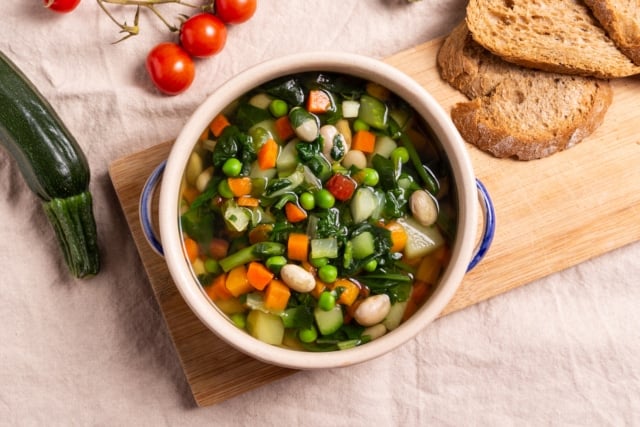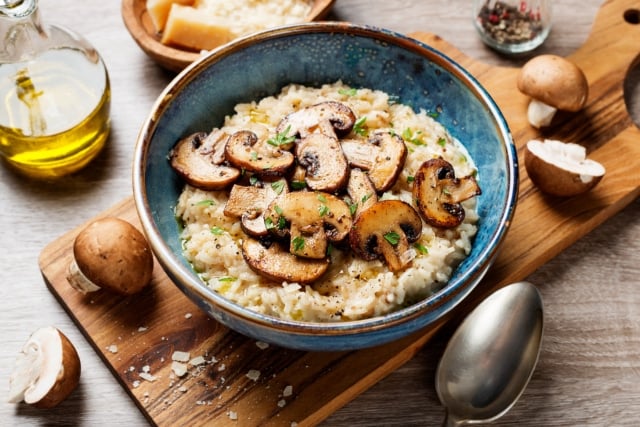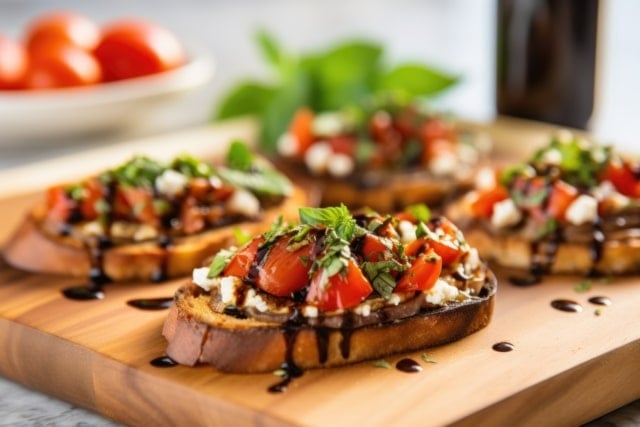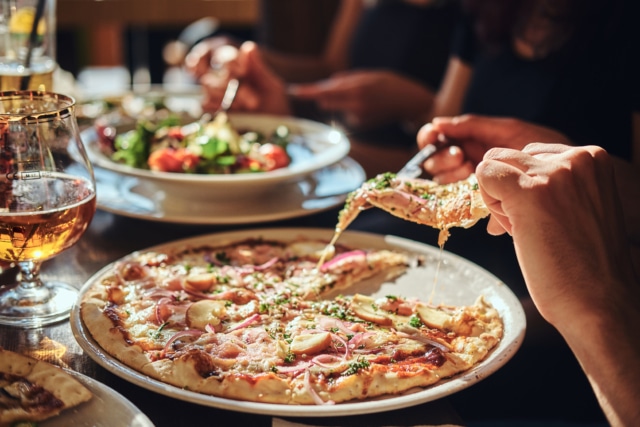![]()
Diana Barkley
(Senior Editor)

It’s no surprise that Italy has dominated the international food scene. On top of the European country’s refined art and extensive history, Italy has long been a top contender for achieving culinary excellence. Learn here everything you need to know about Italian food.
Italian food is defined by its simplicity. It doesn’t overly exaggerate its ingredient list. Instead, it focuses on the quality and freshness of the components you use, whether it’s the sprigs of basil you place on top of a pizza or the white burrata ball you add to your salad.
Overall, Italian food’s delectable characteristic has made it stand out among other global cuisines.
Traditional Italian Cuisine- More Than Pizza & Pasta

Traditional Italian Cuisine- More Than Pizza & Pasta
In every discussion about Italian food, pizza and pasta are almost always mentioned. While they remain timeless dishes in Italian cuisine, they don’t define it. Italian food boasts a wealth of flavors, from the bold taste of a Melanzane alla Parmigiana to the comforting slurp of a chicken gnocchi soup.
The country’s recipes are built upon generations of culinary standards. Picture this: you’re invited to an Italian friend’s home, and their grandmother decides to make a special risotto con Crema di Scampi for you.
Each spoonful you take will likely evoke feelings of comfort and warmth crafted from decades of recipe testing.
That said, Italian cuisine is more than pizzas and pasta. It’s about using the freshest ingredients and most flavorsome herbs, whether it’s to make a crusty focaccia bread or vibrant pesto sauce.
The cuisine relies on base ingredients when creating its meals. These elements include cheese, cured meat, and dough.
Most Popular Street Food in Italy

Most Popular Street Food in Italy
Whether you’re a tourist taking a stroll in Rome or someone hoping to expand their street culinary knowledge, check out some of the most popular street foods in Italy you can explore.
Arancini

Arancini
Arancini is a staple street snack in Sicily. The dish’s name translates to “little oranges” because the golden fried rice balls resemble them. Once you bite into an Arancini, you’ll either taste minced meat, crushed peas, or get a long stretch of cheese.
The balls are made by rolling the ingredients in a tight ball before coating them in breadcrumbs and plopping them in a fryer for a satisfying, crunchy exterior.
Lots of food carts dotted around Italy serve these heartwarming delicacies and sometimes offer a flavorsome arrabbiata sauce topping.
Panelle

Homemade socca or farinata on grey back
Also hailing from Sicily are the famed fritters known as Panelle. These are cut chickpea polenta slices fried in olive oil.
You can choose to eat the hearty dish as a sandwich with a generous ricotta helping or alone with a squeeze of lemon for extra tang. Here’s a mini-history lesson. Panelle was originally introduced to Italy by the Arabs and North Africans during the 9th and 11th centuries.
Frico

Frico
Frico is an exceptionally wholesome street dish. Originating in Carnia during the 15th century, it consists of an omelet stuffed with onions, butter, potatoes, and Montasio cheese.
You have to eat it warm to get the full melted cheese experience. The dish is usually fried in olive oil, but some options also come baked if you don’t want to feel too heavy after the meal.
Pani Ca Meusa

Panino con la Milza
Pani Ca Meusa isn’t your regular cheese-stuffed or fried Italian street food. It’s a sandwich made with strips of calf lungs or spleen.
Originally found in Palermo, Pani Ca Meusa translates to “bread with spleen.” You can dress your sandwich with a spritz of lemon or sprinkle some shredded caciocavallo cheese to top it off.
Italian Food in the World

Italian Food in the World
Italian cuisine knows no borders. You can find a plethora of Italian meals served internationally in restaurants and eateries. Almost everyone’s had some taste of Italy at one point in their life. It could’ve been a slice of New York pizza or a twirl of creamy carbonara pasta.
Tiramisu

Tiramisu
Tiramisu is an Italian dessert consisting of coffee-soaked Savoiardi biscuits layered with a thick serving of mascarpone cheese mixed with eggs and sugar. The treat is topped off with a generous dusting of cocoa powder.
By the end of the 20th century, this coffee-flavored dessert made its way to international menus. It gained such wide prominence that you can find tiramisu-flavored products, like protein powder, yogurt, and ice cream.
Meatballs in Sauce

Meatballs in Sauce
Contrary to some popular beliefs, meatballs in sauce aren’t an authentic Italian dish. Instead, the meal gained fame after Italian immigrants ventured to the West and created their take on pasta. These migrants particularly came to New York between the years 1880 and 1920.
In Italy, at the time, meat was pricey and inaccessible to the migrants. Upon arriving in the U.S., the Italian travelers found that the commodity was much more affordable and used it more often.
In terms of the sauce, the Italian immigrants preferred marinara because canned tomatoes were readily available in grocery stores. Thus, the prized spaghetti and meatballs meal was born.
Carbonara Pasta

Carbonara Pasta
Carbonara pasta’s history is a subject of debate. Its origins stretch to several possibilities.
Some speculate the dish was influenced by the pasta Cacio e Uova, which is a Neapolitan pasta mixed with whisked eggs, lard, and cheese. Meanwhile, others choose to focus more on the pasta’s etymology.
Carbonara translates to “coal burner” from “carbonaro.” Consequently, it could’ve been a working man’s easy-to-make meal.
With such a wide range of origin possibilities, carbonara holds equally wide-ranging variations. Some recipes swap cured meat for sauteed shrimp, while vegetarian options toss meat altogether for roasted artichoke.
Other cultures prefer adding more spices, rather than sticking to the traditional standalone black pepper. Overall, carbonara pasta is a highly versatile meal that can suit an international audience with a few tweaks.
Lasagna

Lasagna
Lasagna’s story starts in Greece. Despite that, if it wasn’t for the Romans conquering the region in 146 BC, the delectable dish wouldn’t have been as prominently known.
The Romans became fond of the lasagna noodles layered with various toppings. As they assimilated the dish into their customs, it reached its way to Italy, where chefs modified it in all its glory.
By the late 1800s, the lasagna made its way to Western shores via Italian immigrants. Years of crafting the dish had earned the Italian meal a place on most Western dinner tables.
The dish’s staple ingredients included noodles, minced meat, slow-cooked tomato sauce, and a generous dusting of parmesan cheese.
Pizza

Pizza
We couldn’t complete this list without mentioning almost everyone’s favorite Italian comfort meal, pizza. Interestingly, the craft of twirling a Neopolitan pizza in the air became one of the country’s UNESCO Intangible Cultural Heritage features.
Before earning fame and love from around the world, pizza was considered a poor people’s food since it was a mere piece of bread covered in tomato sauce or oil.
Nevertheless, the Italian staple has come a long way from being stigmatized. In Western viewpoints, it became an easy-to-make meal and aligned with the “American way of life.”
How Healthy Italian Food Is

How Healthy Italian Food Is
Not only does every bite or slurp of Italian food offer an exquisite taste, but multiple health benefits as well. Now, that doesn’t necessarily mean all Italian meals are considered healthy.
Check out our guides below on the health pros you can get from Italian foods, which foods you should target, and which to avoid.
Health Benefits of Italian Food

Health Benefits of Italian Food
Italian cuisine’s health benefits primarily stem from its use of fresh and nutrition-packed ingredients. Check out how those meals can earn their place in a healthy diet.
Heart Health

Heart Health
Italian food often prioritizes using olive oil in its cooking. The prime ingredient is composed of monounsaturated fats and omega fatty acid-dense.
In addition, olive oil is packed with inflammation-fighting minerals that can reduce your likelihood of heart disease and other medical complications.
Veggie Boost

Veggie Boost
While most would picture carbs when they think of Italian meals, the European cuisine holds multiple vegetable-filled recipes.
From the Eggplant Parmigiana to the Pasta Primavera, you can uncover a host of vegetarian-friendly meals that boost your nutrition intake and decrease your blood pressure.
Fresh Ingredient Focus

Fresh Ingredient Focus
Italian cooking often relies on using fresh produce and ingredients to create the tastiest outcome. Locally sourced vegetables and meats provide more health benefits compared to out-of-season imported options that carry preservatives and processed additives.
Freshness aside, the simplicity of the recipes also makes Italian cuisine healthier. For instance, pasta is only made of flour, eggs, and water. You don’t have to add any butter, oils, or other fats to the original recipe.
Vitamin Intake

Vitamin Intake
Italian meals can easily provide you with the necessary vitamin intake. For example, you can get your vitamin C and folate intake from a tomato sauced pasta or lasagna.
Meanwhile, a healthy serving of basil pesto pasta can source some of your vitamin A, K, Iron, and Manganese intake. Italian cuisine also includes a nutritious helping of nuts, like walnuts, almonds, and pistachios, all carrying a wealth of fiber and antioxidants.
Fill in on Carbs

Fill in on Carbs
Despite carbs getting a bad rep, they’re a major source of your energy. Your diet should at least consist of 45 to 65 percent of carbs.
That said, Italian food can easily help you fill in on your carb requirements.
Pizza and pasta may not be the most nutritionally-dense options to use for your carb intake.
Subsequently, you can add whole-grain ingredients rather than refined white flour to get the most out of your delicious Italian meal.
Antifungal Properties

Antifungal Properties
Lots of Italian ingredients carry antifungal properties, including garlic, onions, and olive oil. Garlic, in particular, is one of the strongest choices that can manage a healthy microbiome for your digestive system.
The root vegetable also stimulates your body’s detoxification process through its liver and colon.
Besides that, olive oil contains a chemical known as Oleuropein. Its antifungal properties fight off Candida. The ingredient also helps stabilize your blood sugar levels.
Low-Calorie Options

Low-Calorie Options
You might run into a situation, where you’re on a diet and have to order something off an Italian menu. In this case, you can opt for several low-calorie options, such as a bruschetta or a summer Faro salad.
Healthy Versus Unhealthy Italian Foods

Healthy Versus Unhealthy Italian Foods
After reviewing the benefits of Italian foods, let’s look at which foods you’ll want to go for and which to avoid.
Healthy Options

Healthy Options
Among the healthy Italian food options are choices like:
- Minestrone: The Italian soup will load up on your vegetable intake and fill you with its generous carb helping, whether from added rice or pasta.
- Spaghetti Marinara: For a healthier take on pasta, you can indulge in a veggie-rich Spaghetti Marinara. We suggest swapping your white pasta with a more filling whole-grain option.
- Steamed Neapolitan-Style Seafood: Get your omega-3 fatty acid intake from a healthy serving of delectable steamed seafood, including mussels and clams. You can flavor the broth with garlic, onions, and tomatoes. Then, complete the dish with a nutritious drizzle of olive oil.
- Chicken Cacciatore: This dish is ideal for those looking to create a hearty meal with robust and bold flavors while maintaining health benefits. The Italian meal is protein-rich and filled with various vegetable options, such as mushrooms and tomatoes.
Unhealthy Options

Unhealthy Options
While these choices may be categorized as unhealthy, that doesn’t mean you should deny yourself an entrancing cheesy bite of pizza. Eating healthy means striking a balance. Having these meals every once in a while will keep you on a healthy track.
- Anything Fried: Italian cuisine boasts plenty of cooking styles, and one of them involves deep-frying, whether it’s for making an Arancini, Crocchè, or a Panzerotti. Regularly consuming deep-fried meals can cause heart issues in the future.
- Cannelloni: This popular Italian favorite may offer a delicious dinner idea, but the added fats from the ricotta and high-calorie pasta shells make this an unhealthy option. Whether you’re making the sweetened or savory version, these are best for occasions.
- Risotto: Risotto often pushes a lot of fat intake as well from the parmesan cheese and butter mixed in. The hard-to-resist meal also holds a lot of sodium. Rather than push it away altogether, you can add healthier elements to it, like lean proteins and fresh vegetables.
- Pizza: The vast majority of pizzas are high in sodium, carbs, sugar, and calories. A more generous cheese-topping also equates to a higher fat content. Consequently, Italian food can lead to high cholesterol and heart disease.
Famous Italian Dishes You Have to Try

Famous Italian Dishes You Have to Try
Trying to pick an Italian dish to try can be challenging. The good news is that there’s a choice for every palette. Here are some of the must-try Italian dishes you’ll want to try on your next trip to an Italian restaurant or the country itself.
Napoletana Pizza

Napoletana Pizza
Classics like the Napoletana Pizza are rarely a miss. This is where it all started: a piece of flatbread with tomato and cheese toppings. It’s a simple meal but with vast culinary opportunities. The Napoletana Pizza, as its name suggests, originated in the Italian city of Naples.
Now, this pizza isn’t like any other you’ve consumed at your local pizzeria or commercial chain. The Italians have even set strict guidelines to define a Napoletana pizza.
They detail that it needs to be baked in a wood-fired oven for about a minute, following a particular diameter and width of raised edges. It also has to include traditional ingredients, including fresh basil, star buffalo mozzarella cheese, and tomatoes.
While these ingredients may appear simple, you still get an exceptionally smoky result with a subtle char and bold flavor. Despite being a dish of the poor during the 18th century, the recipe withstood the test of time and maintained its prized originality for all to enjoy today.
Ossobuco

Ossobuco
Ossobuco translates to “bone with a hole,” which is what you first see in this dish. The Italian, wholesome meal consists of a stew with a veal shank accompanied by vegetables. For reference, veal is the meat found in a cow’s calves.
The dish made its presence in Italian cookbooks during the 19th century. Nonetheless, Ossobuco may be traced back to the 18th century. Originally, the Italian dish was made for large families at the dinner table. Its warmness made it a perfect addition every winter.
Soon, it began to spread across Italy and gained prominence as the Italian version of American comfort food. Making this dish involves placing the veal shank, bone-in, in a stove on low heat along with vegetables and white wine.
After all the flavors of the pot’s components infuse together, you’re left with a heartwarming winter dish to accommodate a whole family.
Ossobuco is considered a luxurious dish in Western settings due to its high-quality meat component. You can also find several variations of the fall-off-the-bone meal that incorporate butter and spices for added tenderness and flavor.
Burrata

Burrata
If you’ve cruised through social media’s Italian food links, you’ll likely see a large white ball at some point, surrounded by a bunch of cherry tomatoes. That ball is none other than the famed Italian Burrata cheese.
Some people enjoy consuming the cheese on its own. Others like to infuse it in various dishes, including shrimp, Neapolitan pizza, and spaghetti al pomodoro.
While it may be used as a side dish, the cheese can shine as the star of a salad meal. Several recipes add the creamy centerpiece with an assortment of tomatoes and basil with a generous drizzle of olive oil and balsamic glaze.
History-wise, burrata’s earliest history was during the 1920s in the southern Italian Murgia region. Residents created the cheese as a necessity to reduce food waste.
You can thank the local cheesemaker, Lorenzo Bianchino Chieppa for inventing this creamy masterpiece that has spread all over the world.
Risotto

Risotto
The North Italian dish is typically cooked with butter and cheese for a creamy result. The main instruction you have to follow to create a soft texture is to cook the risotto low and slow in broth.
Risotto, like pasta, offers you several variation opportunities. Italians of various regions don’t usually stick to one type of rice when making risotto. They choose between variations like Carnaroli, Vialone, and Arborio options.
One of the most popular risotto additions is parmesan cheese and mushrooms. Alternatively, you can create a seasonal risotto during the fall months by making a savory butternut squash and sage risotto.
We highly recommend adding shellfish or sausage if you want to incorporate some protein into the creamy mixture.
Polenta

Polenta
Polenta, for some, is like a blank canvas waiting to be painted with rich flavors, whether that includes adding mushrooms, meat, spices, sauces, and vegetables. For others, polenta is perfect just as it is.
In essence, the dish is made by boiling ground cornmeal in water until you achieve a thick paste-like consistency. Next, you can add salt and season the polenta to your liking.
You don’t have to stop there. Instead, you can spread the yellow mixture on a baking sheet, slice it, and pan-fry it until golden.
You’ll get a crispy exterior with a smooth interior. Serve it with some marinara sauce and top it with parmesan cheese, and you’ve got yourself a tasty appetizer. One of the best parts about polenta is its storage. You can keep it in your fridge in a sealed container for up to five days.
Ragù alla Bolognese

Ragù alla Bolognese
Upon first glance, Ragù alla Bolognese will resemble the famed spaghetti and meatballs. Nevertheless, this Italian classic is different and offers a more refined dish. Originally, in 1891, the recipe was crafted using onions, celery, carrots, and veal cooked in a meat broth.
Some variations included adding other ingredients like mushrooms, chicken liver, creams, and truffles. Nowadays, Ragù alla Bolognese consists of tomatoes, minced meat, salt, and pepper, in addition to the ingredients of the original recipe in 1891.
In terms of the pasta, the recipe calls for flat egg noodles that ideally soak up all the rich flavors of the veggies and meat packed in the broth. The extra surface area in the pasta allows you to take in more meat in each bite.
Soups & Salads

Soups & Salads
We can confidently say that Italians have cracked the code when it comes to creating the most comforting and satisfying soups and salads. Here are some options that’ll make for exceptional additions to your daily meals.
Stracciatella

Stracciatella
Stracciatella is essentially an Italian version of egg soup. It includes shredded chicken, eggs, peas, grated parmesan, spinach, and basil.
Besides that, you can infuse more flavors into your Stracciatella by adding a couple of tablespoons of parsley or a subtle dusting of lemon zest.
Freshly ground nutmeg makes for a flavorful, warm, and spicey addition. Subsequently, these additions make it an ideal healthy appetizer or snack, especially if you’re feeling under the weather.
Now, when searching for Stracciatella recipes online, you might get confused, because the term is ambiguous. It can refer to other Italian meals, namely gelato and cheese. Subsequently, you’ll want to add “soup” to your search.
Pasta Fazool

Pasta Fazool
Pasta Fazool, originally referred to as Pasta e Fagioli, is a soup that combines beans and pasta. It’s popularly called Pasta Fazool because of the similar Neopolitan name, pasta e fasule. Similar to pizza, Pasta Fazool started as a peasant dish since it combined cheap ingredients.
While the recipe’s ingredients remain the same, you can incorporate variations on the type of pasta and beans you use. Typically, Italians like to include cannellini or borlotti beans. In terms of the pasta, you can use elbow or ditalini options.
As for the broth, it can include chopped onions, minced garlic, ground oregano, and chopped red pepper. Overall, you’ll have a perfect soup to warm your heart on a bitter and cold evening.
Sicilian Meatball Soup

Sicilian Meatball Soup
On some days, you might be craving a filling meal, but don’t want a carb-intense option. Enter the Sicilian meatball soup. This Italian dish primarily adds, as its name suggests, meatballs.
Now, a lot of recipes include vegetables like carrots, celery, and zucchini. Nonetheless, the original Sicilian meatball soup focuses more on creating a flavor-intense vegetable stock that you can either make from scratch or buy commercially.
Artichokes and Bottarga Salad

Artichokes and Bottarga Salad
The artichokes and Bottarga salad, also natively referred to as Insalata di carciofi e bottarga, offers a fresh and nuanced twist on your regular lettuce and tomato salad.
Originating from the Italian island of Sardinia, the salad mixes lemon water-soaked artichokes, cured fish roe pouch, and radicchio.
Once those components are cut and combined, you can drizzle a bit of olive oil and sprinkle some salt to complete the salad delicacy.
Insalata di Riso

Insalata di Riso
The Insalata di riso is the perfect choice for a satiating salad. It holds multiple ingredients, including cooked rice, mushrooms, mozzarella, peas, tomatoes, pine nuts, tuna, and bell peppers. Once mixed, you’ll have a colorful lunch to look forward to eating.
Panzanella

Panzanella
If your bread is starting to look a little stale, don’t throw it out. Instead, make a Tuscany-originated panzanella salad. The dish calls for adding tomatoes, red onions, and basil to the stale bread. Before tossing the ingredients, pour a generous drizzle of olive oil and vinegar.
Starters, Sandwiches, and Sides

Starters, Sandwiches, and Sides
Italian starters, sandwiches, and sides offer more than the classic garlic bread. You can explore other tasty options like a simple bruschetta or an indulgent caprese chicken sandwich.
Bruschetta

Bruschetta
Bruschetta is an aesthetically pleasing starter made using three simple ingredients. Prepare a few slices of toasted bread, rub them with garlic to infuse its essence, and carefully pile an assortment of chopped tomatoes on top.
Garnish the bruschetta’s top vibrant red with a complimentary and appetizing green from some sliced basil leaves.
Chicken Caprese Sandwich

Chicken Caprese Sandwich
As with most Italian recipes, the chicken caprese sandwich only requires a few ingredients. You’ll need bread, roasted chicken, bocconcini, arugula, sliced tomatoes, basil, and a truffle mustard sauce.
The creaminess of the cheese and the tang of tomatoes and arugula will complement each other exceptionally well.
Ciabatta Sandwich

Ciabatta Sandwich
Ciabatta bread is distinguished for its airy texture and holed interior. The artisan bread is an exceptional bread choice for making chicken, caprese, or ham and salami sandwiches.
Combine the meat with a slab of mozzarella, sliced tomatoes, and a couple of basil leaves, and you’ve got a decadent lunch.
Caprese Stuffed Portobello Mushrooms

Caprese Stuffed Portobello Mushrooms
Caprese stuffed portobello mushrooms are a must-try for creating a winning side dish at your dinner party.
The vegetarian delicacy gives you a texturally pleasing mixture of softness from the cheese and tenderness of the mushrooms.
Mains

Mains
Italian cuisine holds a plethora of choices that suit all tastes, whether you enjoy gorging on meat or prefer a vegetarian option.
Braised Chicken all’Arrabbiata

Braised Chicken all’Arrabbiata
All’arrabbiata translates to “in an angry style” in Italian. The translation likely refers to the high spice level in the tomato marinara sauce of the recipe.
The flavor-intense meal combines chicken braised in a variety of peppers in a wood-fired oven. You can serve the fiery-tasting chicken with a dollop of soft polenta to balance out the heat-packed flavors.
Veal Milanese

Veal Milanese
As the main dish’s name hints, veal Milanese originates from the Italian city of Milan. Contrary to the traditional frying method, the veal in this recipe doesn’t require eggs or flour.
Instead, you’ll just need to press the meat with breadcrumbs and pan-fry it until golden brown. You can serve the hearty dish with a side of roasted potatoes, fries, or a parmesan-topped arugula salad.
Florentine Steak

Florentine Steak
Emerging from Tuscan cuisine comes the prized Florentine steak. What makes this piece of meat special is that it traditionally comes from Chianina cattle, particularly loin cuts near the rib cage.
To prepare the dish, marinate the high-quality meat in rosemary, olive oil, and balsamic vinegar before placing it on a grill to char and cooking it in the oven.
Stuffed Eggplant

Stuffed Eggplant
Stuffed eggplants are a vegetarian Italian classic. The dish involves scoring the eggplant halves, coating them with olive oil and seasoning, then cooking them in the oven.
Afterward, carve out the eggplant’s innards and mix them in a separate dish with tomato sauce, mozzarella, and basil leaves. Stuff the mixture into the holed-out eggplants and place in the oven until everything melds together to create a flavor-bursting, versatile meal.
Bread, Pastries, and Dessert

Bread, Pastries, and Dessert
We’ve talked about pasta, pizza, and meat dishes, but there’s still a lot more. You can find a wealth of options when it comes to the country’s selection of breads, pastries, and desserts.
Focaccia

Focaccia
Focaccia is a scrumptious Italian oven-baked bread. You can often find various topping options for the warm starter, including rosemary, sea salt, and tomatoes. The bread is highly versatile since you can serve it as a starter, add a filling to create a sandwich, or use it to make pizza bianca.
Pane Toscano

Pane Toscano
Translating to “Tuscan bread,” Pane Toscano is a salt-free bread that holds a compact and spongy interior with a crusty outer layer. Due to its bland taste, the bread is typically served and eaten with sliced cured meats and cheeses.
Panettone

Panettone
Panettone was born during a lavish Christmas banquet held by the Duke of Milan. During the event, the dessert was burnt.
Luckily, a cook named Toni improvised and created a dessert pastry composed of brioche bread, candied fruit, and raisins. It was a hit among the royals and went on to symbolize liberty by 1821.
Gelato

Gelato
Often confused with ice cream, gelato offers a distinctly silkier and denser texture. Meanwhile, ice cream often has a higher air content, making it fluffier and softer.
Gelato flavors are usually naturally derived. For instance, some of the most common options include pistachio, vanilla, strawberry, and mango, all of which give you a refreshing and cold lick perfect for a hot summer day.
Panna Cotta

Panna Cotta
Panna cotta refers to “cooked cream.” Hailing from the Italian region of Piedmont, the dessert consists of sugar, gelatin, and cream. It has an impeccably smooth and creamy texture. You can infuse multiple flavors, such as vanilla and coffee, then top it off with a traditional sliced berries topping.
Secret Recipe Tips

Secret Recipe Tips
The art of cooking Italian food requires technique, which is passed down from generations of cookbooks and grandmas. Check out some tips to refine your Italian cooking expertise.
Use Fresh Herbs

Use Fresh Herbs
Always use fresh herbs when cooking or seasoning your meals. It’ll ensure a higher meal quality result and infuse your dish with more authentic Italian flavors.
Think Simple

Think Simple
Prioritize one or two main flavors in your dish. Italian cuisine thrives on its simplicity. Whether it’s the spicy tomato from an arrabbiata sauce or the creamy mushroom flavors in a risotto, keep your flavors distinct.
Don’t Forget the Salt

Don’t Forget the Salt
When cooking pasta, add a generous amount of salt to the boiling water. It’ll accurately season the pasta and make your pasta water a better addition to your sauce.
Pasta Shapes Do Matter

Pasta Shapes Do Matter
Choose the correct pasta for its corresponding sauce. Sauces stick to pasta shapes in different ways. For instance, fettuccine often pairs well with light creamy sauces, while ravioli works better with oil or butter-based sauces.
Keep the Pasta Water

Keep the Pasta Water
Don’t discard pasta water. Add it to your sauce as you cook to incorporate it as a flavoring and thickening agent.
- Season As You Cook: Don’t leave the seasoning to the end. Add it as you cook and taste test to ensure it’s just the right amount.
- Ditch the Oily Pasta Water: There’s no need to add oil when boiling the pasta. It’ll make it more difficult for the sauce to cling to the pasta.
- Save the Cheese Rinds: Don’t discard any cheese rinds. Save them for your soups, stocks, and broths.
- Season Your Oils: You can add rosemary, thyme, and oregano to your oils and allow them to infuse overnight.
- Toast Your Risotto: When making risotto, toast the rice before adding the liquids. It’ll create a richer and nuttier flavor profile.
Beverages

Beverages
Italian beverages are prominently caffeinated drinks you’d likely find at any local coffee shop nowadays, including mochas, lattes, and macchiatos.
Cappuccino

Cappuccino
Cappuccino is one of the most widely ordered caffeinated beverages globally. The espresso-based drink dates back to 1930 in Italy, when it was originally served with whipped cream. Nowadays, it’s topped with frothy steamed milk.
Bicerin

Bicerin
Bicerin is an espresso-based drink that has an added hot chocolate layer and topped with whipped cream. Typically, the drink comes in a clear glass so you can see all three layers.
Shakerato

Shakerato
Shakerato is like the Italian version of iced coffee. It’s primarily made of espresso, mixed with sweet syrup, and served with ice cubes. Interestingly, the drink is prepared using a cocktail shaker. Once poured, you’ll notice a frothy top layer.
Ingredients

Ingredients
Italians take their ingredient quality seriously. While simple, each ingredient creates an array of flavors, whether tangy, sweet, sour, or smooth.
- Pasta: The Italian ingredient comes in all shapes and sizes. The remaining constant are its egg and flour components.
- Tomatoes: Italian soil and tomatoes are the ideal match. It’s hard to imagine Italian cuisine without this red fruit.
- Olive Oil: Used for garnishing, dressing, frying, and dipping, a vast majority of Italian cuisine relies on this liquid elixir.
- Balsamic Vinegar: Italian food often relies on balsamic vinegar for its tangy flavor addition as a dressing and marinade.
- Cheese: With a market size of $12.82 billion in Italy, you can’t deny this ingredient’s prominence in the country’s everyday meal plan.
- Garlic: Whether sauteed, pan-fried, or rubbed on bread, garlic is essential in Italian cooking.
- Mushrooms: Popping in Italy’s woods, mushrooms are prized for their versatility and application in the Mediterranean country’s cuisine.
Herbs and Spices

Herbs and Spices
Herbs and spices are the essence of Italian cuisine. They infuse fresh, bitter, and earthy flavor notes, further refining your Italian meal.
- Basil: The herb is often an ingredient in pestos, salads, and sandwiches. When dried, you can sprinkle it in soups and meats for a stronger, aromatic flavor.
- Thyme: It gives off a subtle minty flavor with sweet notes. Its dried version produces a more pungent taste that pairs exceptionally well with garlic and lemon.
- Oregano: This herb is more popular as a pizza topping and pasta sauce ingredient. Nonetheless, its versatility can allow you to sprinkle some on soups and stews as well.
Italian Food Culture

Italian Food Culture
Italians have unique food culture habits worth knowing about, especially if you’re visiting the nation soon. Learn here more about the eating habits and how meals are structured.
Eating Habits

Eating Habits
Italians usually start their morning with a light and sugary breakfast. They like to reserve their appetite for heavier lunch and dinner meals.
Unlike Western cultures, Italians consume a large lunch meal to satiate them throughout the day. When it comes to coffee, Italians usually drink it after their meal, unless it’s breakfast.
Meal Structure

Meal Structure
Meal structures in Italy go as follows: Between 7 AM and 10:30 AM, Italians have their breakfast. By noon from 12:30 PM to 2:30 PM, they enjoy their lunch.
Meanwhile, dinner is traditionally consumed between 8 PM and 10 PM. If they’re hungry between lunch and dinner, they have an “aperitivo” or light snack from 6 PM to 8 PM.
Etiquette

Etiquette
In terms of etiquette, here are some rules to follow:
- Avoid eating with your elbows on the table
- When eating pasta, don’t reach for the spoon
- Hold the fork with your right hand and the knife with your left
- Don’t switch utensils while eating
- Always pass the food to the left
- Don’t get a meal with cappuccino
- Leave a 10 percent to 15 percent tip at restaurants
#Italian #Food #Popular #Dishes #Secret #Recipe #Tips




